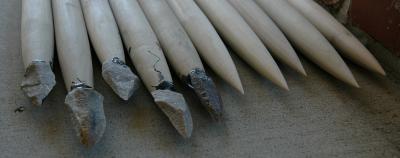Stone-tipped and sharpened wooden spears comparison demonstrates differences in penetration, damage
Source - http://www.eurekalert.org/pub_releases/2014-08/p-ssm082114.php

Tips of spears featured in the experiment. Credit: Jayne Wilkins et al.
Experimental comparison may show that stone-tipped spears do not penetrate as deep, but may still cause more damage, than sharpened wooden spears, according to a study published August 27, 2014 in the open-access journal PLOS ONE by Jayne Wilkins from Arizona State University and colleagues.
The creation of stone-tipped weapons (wooden shaft + binding materials + stone point) by our ancestors ~500,000 years ago points to the development of new cognitive and social learning at the time. The development may have provided an advantage over simpler hunting methods, such as using a sharpened wooden spear, but how it influenced hunting is unknown. In this study, researchers shot six stone-tipped and six sharpened wooden spears at gelatin to test whether stone-tipped weapons penetrated deeper in the gelatin. They then analyzed the penetration depth and damage each weapon caused in over 200 wound tracks.
Results show that tipped spears did not penetrate deeper into gelatin than untipped spears, but they did create a significantly larger and wider wound cavity. This cavity may have increased the relative "killing power" of the tipped spear, and they may have ultimately caused more damage. The authors posit that tipped spears may have provided an advantage over wood-tipped spears to human and Neandertal ancestors, potentially affecting the hunting success, resulting in important implications for human adaptation and life history.
Jayne Wilkins added, "Hafting a stone point to the end of spear was an important innovation that changed life for Pleistocene humans. Humans with stone-tipped spears were more likely to kill the game that they targeted, and were able to secure high quality food resources more frequently and regularly."
Citation: Wilkins J, Schoville BJ, Brown KS (2014) An Experimental Investigation of the Functional Hypothesis and Evolutionary Advantage of Stone-Tipped Spears. PLoS ONE 9(8): e104514. doi:10.1371/journal.pone.0104514
Funding: This research was supported by the Social Sciences and Humanities Research Council of Canada.